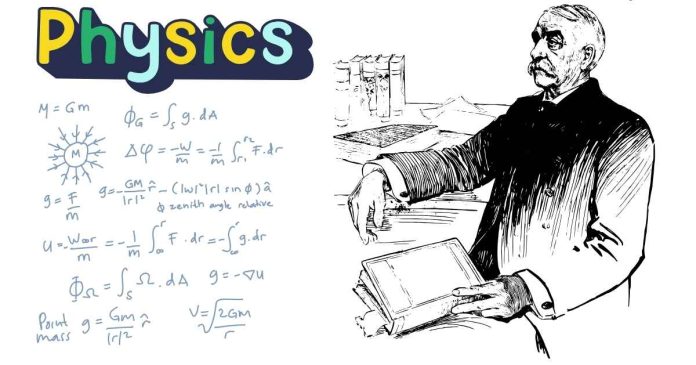Physics is one of the oldest and most significant fields of science, with two major periods marking its evolution: classical physics and modern physics. Classical physics dominated scientific thought for centuries, while modern physics, emerging in the late 19th and 20th centuries, revolutionized our understanding of the universe. Throughout history, a few key figures have been recognized as the “fathers” of these two distinct branches of physics.
In this article, we will find out about the individuals credited with being the fathers of both classical and modern physics: Isaac Newton and Albert Einstein.
Father of Classical Physics: Isaac Newton
Isaac Newton (1642–1727), an English mathematician, physicist, astronomer, and author, is widely regarded as the “father of classical physics.” His contributions to the field laid the groundwork for much of the physics that followed and formed the basis of classical mechanics.
Key Contributions:
- Laws of Motion: Newton’s Three Laws of Motion are fundamental principles that describe how objects move under the influence of forces. These laws provided the framework for classical mechanics and are still taught in physics classrooms around the world today.
- The first law (the law of inertia) states that an object in motion will stay in motion unless acted upon by an external force.
- The second law (force equals mass times acceleration) describes the relationship between an object’s mass, the force applied to it, and the resulting acceleration.
- The third law (action and reaction) states that for every action, there is an equal and opposite reaction.
- Universal Law of Gravitation: Newton formulated the Law of Universal Gravitation, which states that every mass attracts every other mass in the universe with a force that is proportional to the product of their masses and inversely proportional to the square of the distance between them. This law helped explain the motions of celestial bodies and was crucial for understanding planetary orbits.
- Mathematics: Newton is also known for his development of calculus (independently from Gottfried Leibniz), which became an essential tool for solving problems in physics and engineering. Calculus helped in the description of motion and change, providing the mathematical foundation for the laws of motion and gravitation.
- Optics: Newton’s work in optics, especially his discovery that white light is a mixture of colors, helped expand our understanding of the nature of light. He also invented the reflecting telescope, which improved the ability to observe distant celestial objects.
Legacy:
Newton’s work laid the foundation for classical physics and became the dominant framework for understanding the physical world for over 200 years. His theories and mathematical formulations were instrumental in explaining everything from the motion of planets to the behavior of objects on Earth. Classical mechanics, based on Newton’s principles, was the standard model of physics until the early 20th century.
Father of Modern Physics: Albert Einstein
Albert Einstein (1879–1955), a German-born theoretical physicist, is widely recognized as the “father of modern physics.” His groundbreaking contributions to the field revolutionized our understanding of space, time, energy, and matter, leading to the development of what is now known as relativity and quantum mechanics.
Key Contributions:
- Theory of Relativity: Einstein’s Special Theory of Relativity (1905) changed our understanding of time, space, and light. He proposed that the speed of light is constant for all observers, regardless of their relative motion. This led to the famous equation, E=mc², which shows the equivalence of mass and energy.
Later, in 1915, Einstein developed the General Theory of Relativity, which extended his ideas to include gravity. Instead of viewing gravity as a force (as Newton did), Einstein proposed that mass warps space-time, and this curvature of space-time is what we perceive as gravity. This theory has been confirmed by numerous experiments and observations, including the bending of light around massive objects and the recent imaging of black holes.
- Photoelectric Effect and Quantum Theory: In 1905, the same year he published his theory of relativity, Einstein also published his work on the photoelectric effect. He proposed that light could be thought of as both a wave and a particle (a concept known as wave-particle duality). This work helped establish the foundations of quantum theory and earned him the Nobel Prize in Physics in 1921. His work demonstrated that light consists of discrete packets of energy, or photons, a discovery that played a crucial role in the development of quantum mechanics.
- Brownian Motion: Einstein’s work on Brownian motion provided further evidence for the atomic theory of matter. He showed that the erratic motion of particles suspended in a fluid could be explained by the random movement of atoms and molecules, thus offering direct evidence of the existence of atoms.
- Unification of Physics: Later in his life, Einstein worked on attempting to unify the theories of electromagnetism and gravity, though this work was incomplete. His quest for a Theory of Everything laid the groundwork for many of the theoretical frameworks in modern physics, including the ongoing search for a unified theory of quantum mechanics and general relativity.
Legacy:
Einstein’s theories fundamentally changed the landscape of physics. His work is central to modern physics, influencing not only theoretical research but also practical technologies such as GPS systems, which rely on relativity for accurate timing. The development of quantum mechanics and advances in cosmology are built on Einstein’s foundational ideas.
The “father of classical physics,” Isaac Newton, and the “father of modern physics,” Albert Einstein, both made monumental contributions to our understanding of the physical world. Newton’s classical mechanics dominated physics for centuries, explaining everything from planetary motion to terrestrial forces. Einstein, on the other hand, opened the doors to a new era with his theories of relativity and contributions to quantum mechanics, reshaping our understanding of the universe on both the macroscopic and microscopic scales.
Together, these two towering figures in physics laid the intellectual groundwork for all subsequent scientific advancements, and their legacies continue to influence the field today.


